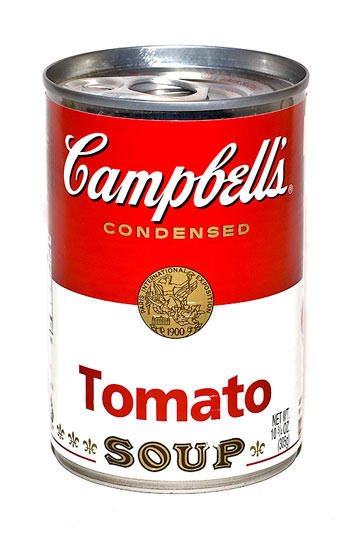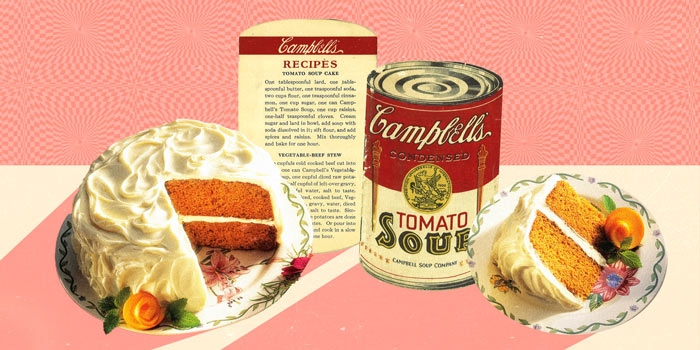Occasional miscellany: Tomato soup cake.
A can of tomato soup is one of those memories universal to the Anglosphere. In the United States, the ubiquitous brand is Campbell’s, rendered iconic by Andy Warhol in a misunderstood and overappreciated painting. Solemn Critics and public alike considered its depiction ironic but the joke was on them all: Warhol was sincere. He liked the soup, a childhood comfort, a fond memory of his mother, and ate it all his life.
In Britain the brand is Heinz, so indispensable that when Jane Fearnley-Whittingstall describes detailed instructions for a number of classic soups in Recipes from an Edwardian Country House she includes but a single can:
“Heinz Tomato Soup
For most of us comfort food of the highest order. Keep a few tins in the larder or store cupboard.
Open the tin, heat and eat.” (Fearnley-Whittingstall 194)
A succinct recipe.

Just little old me.
No fripperies for Fearnley-Whittingstall when it comes to tomato soup, and no Oxford comma either. Sound practice on either count, although a splash of Sherry and dash of hot sauce do no harm. No irony either; the entry is serious, anything but the kind of seriocomic asides that amount to a unitary running text in the culinary work of Christian Isobel Johnstone almost two centuries ago.
Another less accomplished but also idiosyncratic writer, a midtwentieth century Washington socialite called Daisy Breaux, was devoted to canned soups, tomato among them. On the can she is unequivocal:
“Today many brands of canned soups are delectable and it seems useless to go through the process of buying soup-bones, veal-knuckles, vegetable-‘bouquets’ and other ingredients, and the labor of simmering--or making the pot-au-feu for which France is noted, or the famous Boullabaise Marceille [sic].” (Breaux 11)
If all that goes a little far, and nobody has encountered a decent can of boullabaise, the convenience of some canned soups is undeniable. In common with us, Breaux is not so minimalist as Fearnley-Whittingstall. “Cream of Tomato Soup,” she advises her reader, “is more delicious when ‘spiced up’ with a dash of salts, such as celery, onion or garlic, a little Worcestershire, and a pinch of powdered cloves.” The salt is unsound--canned soups are salty--but some celery seed, or onion powder or juice, would be welcome along with the Worcestershire, while the clove adds an eerie but appealing Old School element to the soup. Whether, however, you dilute concentrated tomato with water (our preference) or milk is a matter of taste. Incidentally Breaux leaves her can of soup unbranded.
In addition to the addition of spice and other seasonings, Breaux combines her tomato soup with egg, flour, fruit, lard and sometimes nuts to bake a cake. It is not so eccentric as may first appear. Tomato soup cake has been appearing on American tables for a long time: Several sources place the first recipes in community cookbooks from the 1920s and 30s. (Barber; Taste of the South )
The earliest tomato soup cakes share two elements. They were cheap and simple. Born of Depression necessity,
“frugality was key. The original cakes of this kind were no more than basic sheet cakes, and the soup served as a way to make the cake moist despite using very little oil or dairy products.” ( Taste of the South )
Then the United States entered the second world war, extending the appeal of so simple a cake. In How to Cook a Wolf an invariably acerbic M.F.K. Fisher describes the disorientation, even bewilderment, of frivolous housewives struggling to adjust to the practicalities required by rationing and the shortages attendant to a wartime economy.

She presents two appropriate recipes for cake, first “War Cake,” a name she finds unappetizing and unpleasant, in which “bacon grease can be used” for the shortening “because of the spices that hide its taste.” Although it sounds ghastly, Fisher recalls “liking it so much that I dreamed about it at night like all the other children who ate it.” (Fisher 154) She describes it as “excellent,” “a rather crude moist dark loaf that keeps well and costs little.” She also considers War Cake versatile:
“Sliced thin with a glass of milk, it is a pleasant lunch. Or it can be sliced and toasted, basted with sherry, and served hot with wine sauce for a good dessert, once it seems past its prime. [Wonderful example of understatement! I really mean: “When the cake is curled, stiff, and apparently unusable.”]” (Fisher 22)
Second of course given our subject, Fisher discusses her own sparse and flexible tomato soup cake with a small paradox of sorts. “Another good cake” is her matter of fact introduction to the recipe, an implication that the cake is commonplace, but then she also notes that the “pleasant cake… keeps well and puzzles people who ask what kind it is.” (Fisher 155, 156)
The Campbell Soup Company capitalized on the unlikely vogue for cooking with tomato soup in October 1940 with its own recipe, but not for cake. Instead, Campbell’s took a traditional British technique to create its “Steamed Fruit & Nut Pudding.” “It was,” the company explains, “a classic steamed pudding spiced with cinnamon, nutmeg and cloves, as well as the secret ingredient of Campbell’s Condensed Tomato soup [sic]” (“A Spicy History”), in reality not so secret because those community cookbooks hardly had hidden the fact of its inclusion. The seasoning is a variant of high British spice but the technique for steaming the pudding itself is not quite traditional. In a frugal American twist, and in common with the preferred vessel for Boston brown bread, itself in fact also a steamed pudding, the Campbell Company steams its version in a used can instead of pudding basin or cloth. (Perkins)
By 1949 Campbell’s had converted its pudding to a cake and published the recipe in The New York Times ; during 1960 tomato soup cake was the first recipe the company printed on a can of its soup. (Peters)

Dreaming of Tomato Soup Cake.
Tomato soup cake retains something of a cult following. It was the signature dish of Sylvia Plath, so her legion of acolytes posts recipes and takes tomato soup cake to potluck faculty meetings and other gatherings of the faithful in both the United Kingdom and the United States. A year ago on Instagram, Felicity Cloake tried a recipe. “No one is more surprised than me,” she admits in somewhat unfortunate prose, “that not only is this eggless, flour-heavy tomato soup cake palatable, it’s actually pretty delicious,” if with qualification:
“Certainly not the best of fruit loaves, as it’s rather sweet for my taste, and not as fruity and squishy as I like them, but the tomato flavour entwines so cunningly with the spices that, if you didn’t know, you’d be hard-pressed (I think) to tell what was in it.” (Cloake)
If Cloake found the cake too sweet it would not have required much imagination to reduce the amount of sugar. Did she try it that way? Did she like it better?
The cake featured on the mass market Today show as recently as February 2021, an indication perhaps that plague has pitched the public psychology into something akin to a wartime attitude.
Memoirs by authors from places as far apart as Massachusetts and Nebraska mention tomato soup cake. (Gaunt, Savageau) Far from the Today studio at the soaring art deco fantasy of Rockefeller Center, down in blighted Camden, New Jersey, the canned soup company reports that
“Campbell’s Kitchen still sees many consumers looking for the recipe… with nearly 65,000 views a year to various versions of the recipe at CampbellsKitchen.com.
That figure represents twenty percent of traffic at the site from cooks requesting recipes that incorporate tomato soup. (“A Spicy History”) Fisher’s ‘crude moist loaf,’ in common with her canon, abides on both sides of the Atlantic rim.
Recipes for tomato soup cake and pudding appear in the practical.
Sources:
Anon., “A Spicy History of Campbell’s Tomato Soup Spice Cake,” https://www.campbellssoupcompany.com/newsroom/news/a-spicy-history-of-campbells-tomato-soup-spice-cake/ (5 January 2015) (accessed 5 June 2021)
Anon., “Tomato Soup Cake,” A Taste of the South , https://www.tasteofthe southmagazine.com/tomato-soup-cake/ (24 August 2020) (accessed 5 June 2021
Casey Barber, “The Enduring Allure of Tomato Soup Cake,” Kitchn , https:’’www.the kitchn.com/the-enduring-allure-of-tomato-soup-cake-227786 (29 January 2016) (accessed 5 June 2021)
Daisy Breaux, Favorite Recipes of a Famous Hostess (Washington DC 1945)
Felicity Cloake on Instagram, https://www.instagram.com/p/CCYdp1tBual/ (accessed 16 June 2021)
Jane Fearnley-Whittingstall, Recipes from an Edwardian Country House (New York 2007)
M.F.K. Fisher, How to Cook a Wolf (New York 1942; revised and enlarged 1954)
Carole O’Malley Gaunt, Hungry Hill: A Memoir (Amherst MA 2007)
Victoria Lynn, “Review of Poet Sylvia Plath’s Tomato Soup Cake recipe,” Delishably , https://www.delishably.com/desserts/Review-of-Poet-Sylvia-Plaths-Tomato-Soup-Cake-Recipe (5 January 2020) (accessed 5 June 2021)
Kate Moses, “Baking with Sylvia,” The Guardian (15 February 2003)
Terri Peters, “Tomato soup… in a cake? We tried Campbell’s recipe from 1949,” Today , https://today.com/food/campbell-s-tomato-soup-spice-cake-we-tried-popular-recipe-t209678 (22 February 2021) (accessed 5 June 2021)
Cheryl Savageau, Out of the Crazywoods (Lincoln NE 2020)

